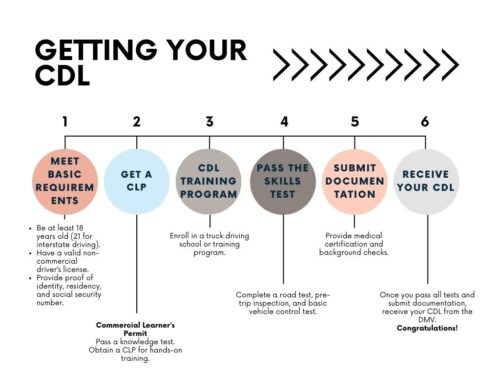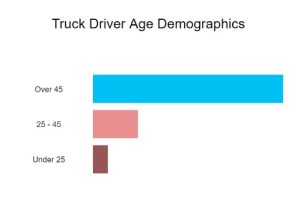Welcome to the ultimate guide to truck driver jobs, tailored for those who value diversity, equity, and inclusion in the workplace. This guide serves as an essential primer for both entry-level job seekers and experienced professionals exploring the vigorous field of truck driving—a sector critical to the livelihood of our economy and everyday life.
Truck driving is not just about transporting goods; it’s about ensuring a steady flow of commerce, supporting industries, and contributing to national growth. With various roles that accommodate different skill sets and personal preferences, truck driving offers unique opportunities for a stable and rewarding career path.
You will discover the essential educational requirements, areas of expertise necessary for progression, and the industry’s current demographic trends. Additionally, we delve into salary and hiring trends to give you a clear perspective on what to expect and how to prepare as part of the workforce. As the trucking industry embraces diversity and innovation, understanding these elements is crucial for anyone looking to enter or advance in this field. Join us as we explore the many facets of truck driver jobs, equipping you with the knowledge to make informed decisions and thrive in your career.
Educational Requirements for Truck Drivers
Truck driving is a vital profession connecting industries and consumers nationwide. The educational path to becoming a truck driver is typically straightforward, but specific requirements can vary from state to state. Here’s what you need to know about the educational requirements for truck drivers.
Basic Educational Requirements
Before delving into specialized training, prospective truck drivers must start with these foundational steps:
- High School Diploma or Equivalent: While not always mandatory, many employers prefer candidates to have a high school diploma or GED.
- Commercial Driver’s License (CDL) Training: The essential requirement for all truck drivers is obtaining a Commercial Driver’s License (CDL). To do this, one must enroll in a state-approved trucking school course that covers critical areas such as driving skills, truck maintenance, and safety procedures.
Commercial Driver’s License (CDL)
Obtaining a CDL is mandatory to drive commercial heavy vehicles. There are several classifications of CDLs, depending on the type of truck being operated:
- Class A CDL: For operating vehicles weighing 26,001 pounds or more or towing trailers heavier than 10,000 pounds.
- Class B CDL: For operating vehicles weighing 26,001 pounds or more without towing a heavy trailer.
It’s important to check specific state requirements, which can guide the prerequisites for these licenses. Getting a CDL involves passing both a written exam and a driving test, which can be prepared for through self-study or attending intensive driving courses. Here’s a step-by-step path to getting a Commercial Driver’s License (CDL):
- Meet Basic Requirements: Age, driver’s license, identity proof.
- Get a Commercial Learner’s Permit (CLP) by passing a knowledge test.
- Attend a CDL Training Program.
- Pass the Skills Test: Road test, pre-trip inspection, basic vehicle control.
- Submit the Required Documentation: Medical certification and background checks.
- Receive Your CDL from the DMV.

Additional Certifications
Depending on their area of specialization, some drivers might need additional certifications, such as hazardous materials (HazMat), which require passing an additional knowledge test and background checks by the Transportation Security Administration.
For entry-level job seekers, exploring truck driving as a career can be a promising path that requires a modest educational investment relative to other professions. For more detailed information on training and requirements, candidates can visit the Federal Motor Carrier Safety Administration (FMCSA) website, which provides resources and guidelines for earning a CD for truck driving and other transportation jobs.
Areas of Expertise for Truck Drivers
Driving a truck is more than transporting goods from point A to point B. The field encompasses various areas of expertise, each requiring unique skills and knowledge. Understanding these can help aspiring drivers decide on a specialization that best suits their interests and abilities.
Long-Haul Trucking
Long-haul or over-the-road drivers often handle cross-country routes and can be on the road for weeks. This role requires:
- High endurance for long hours, sometimes well into the night.
- Deep knowledge of national traffic laws
- Skills in route planning and time management
Heavy Truck Loading
Specializing in heavy hauling involves transporting oversized loads or specialized cargo that can include anything from construction machinery to large-scale industrial equipment:
- Understanding of weight distribution and securing cargo
- Ability to operate various loading equipment
- Additional permits and knowledge of road regulations concerning heavy loads
Regional Delivery
Drivers focusing on regional delivery usually operate within a particular area or state, returning home more frequently than long-haul drivers. This specialization requires the following:
- Good knowledge of local roads and traffic patterns
- Customer service skills, as drivers interact more with clients
Refrigerated Transport
Drivers in this niche handle perishable goods requiring temperature-controlled environments. Key responsibilities include:
- Monitoring temperature settings and ensuring they remain consistent throughout the journey
- Understanding refrigeration equipment and its maintenance
Each area of expertise in truck driving requires specific driving skills and knowledge about safety, legal regulations, and customer interaction. Those interested in a career in trucking can further explore these specializations by visiting resources like the American Trucking Association’s (ATA) website, which offers detailed insight into the industry. Additionally, understanding the administrative aspects of truck driving jobs is crucial, which can also enhance your career prospects in this diverse field.
Demographics in the United States for Truck Drivers
The demographics of truck drivers in the United States reveal a diverse and evolving landscape. Understanding who makes up this essential workforce helps in tailoring training and opportunities.
Age Distribution
Most truck drivers are between 45 and 54 years old, showing a trend towards older workers in the industry. However, efforts to attract younger drivers are increasing to fill the gaps left by retiring drivers. This trend could lead to labor shortages in the future. According to the ATA, the trucking industry could face a driver shortage of 82,000 in 2024. IRU’s March 2024 driver shortage report projects that the shortage could double by 2028 without significant action. To meet demand, the trucking industry may need to recruit nearly 1.1 million new drivers by 2026.

Gender Composition
Historically, truck driving has been male-dominated, with men comprising almost 90% of the workforce. However, more women have taken the wheel recently, encouraged by inclusive hiring practices and equal opportunity policies in many companies.
- Male: 88.1%
- Female: 11.9%

Ethnic Diversity
The ethnic backgrounds of truck drivers are becoming more varied, with an increasing number of Hispanic, African American, and Asian drivers. This shift brings new perspectives and ideas to the industry, cultivating a richer work environment.
- White: 57.2%
- Hispanic or Latino: 20.0%
- Black or African American: 13.7%
- Asian: 4.0%
- Other Ethnicities: This includes smaller groups such as Native Americans and individuals of mixed race, which is approximately 5.1% of the total.

Geographical Distribution
Truck drivers are needed across all states, but Texas, California, and Pennsylvania have the highest employment levels. Each region offers different challenges and opportunities, catering to various job preferences and lifestyles.
The industry adapts as the demographic landscape shifts, offering better support and more opportunities for all. Such diversity strengthens the workforce and enhances the productivity and cultural richness within the truck driving community. Anyone looking to join this critical sector will find a welcoming and supportive environment that reflects the broad spectrum of American society.
Salary Trends for Truck Drivers
Salary trends for truck drivers have evolved over recent years, influenced by factors like experience, location, and specialization. Here’s a detailed look at these trends to help guide career decisions.
National Average Salary
As of recent statistics, the average salary for truck drivers in the United States is approximately $45,000 to $90,000 annually. This range varies based on the type of goods transported and the time spent on the road.
Experience and Earnings
Experience plays a crucial role in determining a truck driver’s salary:
- Entry-level Drivers can expect to start on the lower end of the salary range at around $40,000 per year.
- Mid-career Drivers who have navigated through various driving conditions and cargo types typically see increased earnings of roughly $60,000 per year.
- Seasoned Drivers with decades of experience can earn at the higher end of the salary spectrum, especially if they specialize in hazardous materials handling or oversized loads, earning up to $90,000 annually.
Impact of Location
Geographical location significantly affects salaries:
- Truck drivers in urban areas or regions with high shipping volumes, like Los Angeles or New York, often earn more due to the high demand and cost of living.
- In contrast, rural areas might offer fewer opportunities and lower pay rates.
Future Salary Outlook
The trucking industry is seeing a steady increase in freight transport demand, which is steadily driving up wages. Over the last decade, truck driver salaries have increased by 4% or $12,000 yearly, and the trend is expected to continue. Additionally, as the industry faces a shortage of qualified drivers, salaries will likely rise as companies compete to attract talent.
Understanding these salary trends is essential for those considering a career as a truck driver. They provide a clear picture of what to expect financially and help make informed career choices.
Hiring Trends for Truck Drivers
The truck driving industry is experiencing significant shifts in hiring trends, influenced by technological advancements, economic factors, and legislative changes. Here’s a look at what’s driving the hiring landscape.
Technology Impact
Technological innovations are reshaping how companies recruit and manage truck drivers:
- Sophisticated logistics software helps streamline route planning and tracking.
- Increased use of telematics in trucks provides better data on driver performance and vehicle health, making hiring more strategic.
Regulatory Influence
New regulations also play a crucial role in the hiring trends in this sector:
- Changes in hours-of-service regulations by the Federal Motor Carrier Safety Administration influence how long drivers can be on the road, impacting the number of drivers needed.
- Environmental regulations are prompting companies to invest in more sustainable and efficient transport solutions, affecting the type and number of drivers hired.
Economic Factors
Economic changes can sway the demand for truck drivers:
- An expanding economy generally increases the need for transportation of goods, thus boosting hiring.
- Conversely, economic slowdowns can lead to a reduced demand for drivers.
Demand for Specialized Skills
There is a growing demand for drivers with specialized skills:
- Drivers capable of handling hazardous materials or oversized loads are particularly in demand and can often command higher salaries.
- The push for greener logistics also creates jobs for drivers knowledgeable in eco-friendly vehicles and practices.
These hiring trends highlight the dynamic nature of the truck driving industry. Aspiring drivers should stay informed about these trends to capitalize on emerging opportunities. For more insights into building a career in truck driving, checking out the Bureau of Labor Statistics is a significant next step. Additionally, explore our Guide to Warehousing-Logistics Jobs, which encompasses logistics and transportation management roles.
Education Levels among Truck Drivers
The education levels required for truck drivers vary depending on the job roles and responsibilities. However, the industry offers entry points for individuals with various educational backgrounds.
Minimum Educational Requirements
Most truck driving positions require at least a high school diploma or equivalent. The educational level of truck drivers in the U.S. typically includes the following:
- High School Diploma or Equivalent: Most truck drivers possess at least a high school diploma or equivalent. This level of education is often a minimum requirement for obtaining a commercial driver’s license (CDL) and for employment in many trucking companies.
- Some College or Vocational Training: Many truck drivers attend professional truck driving schools or community college programs lasting 3 to 6 months to gain the necessary skills and certifications. This vocational training is crucial for obtaining a CDL and learning the regulations and operational skills needed for the job.
- Postsecondary Non-Degree Award: Some truck drivers may have a postsecondary non-degree award, which includes completing truck driving school and obtaining a certificate of completion.
- Higher Education: While relatively rare, some truck drivers hold associate degrees or higher educational qualifications. However, the trucking industry primarily requires vocational training and certification rather than formal higher education degrees.
Professional Training and Certifications
Beyond secondary education, professional training and certifications are crucial:
- CDL Training: Essential for all drivers, as discussed earlier.
- Safety Certifications: These include OSHA safety courses and specific driving safety certifications.
- Advanced Driving Courses: Such courses enhance driving technique and knowledge, particularly for handling specialized cargo.
Continuing Education
For those looking to advance in their careers, continuing education is critical:
- Management courses can prepare drivers for supervisory roles.
- Business logistics programs offer insight into the broader transportation field.
This varied educational landscape allows individuals from different academic backgrounds to find opportunities within the truck driving industry. Continuing education is equally important, providing pathways for career advancement and specialization in high-demand areas of the transportation sector.
Skills in Demand for Truck Drivers
As the transportation industry evolves, specific skills have become increasingly valuable for truck drivers aiming to remain competitive and efficient.
Technological Proficiency
With digitization shaping various sectors, truck drivers are expected to be adept with technology:
- GPS and electronic logging devices (ELDs) are used to track routes and hours of service.
- Understanding of transportation management software.
Advanced Driving Skills
Refined driving skills remain at the core of a truck driver’s expertise:
- Defensive driving techniques to ensure safety on the road.
- Ability to handle different types of vehicles, such as tankers or flatbeds, depending on the job requirements.
Communication and Interpersonal Skills
Strong communication is crucial for:
- Interacting with dispatchers, clients, and, occasionally, law enforcement.
- Negotiating delivery details or resolving disputes that arise during transit.
Time Management
Efficient time management is necessary to meet delivery schedules and comply with hours-of-service regulations.
Physical and Mental Stamina
Truck driving can be demanding. Hence, good physical fitness and mental resilience are vital to handling long hours and sometimes challenging driving conditions.
Acquiring and refining these skills can significantly enhance a truck driver’s effectiveness and job satisfaction. Resources like the ATA’s webpage provide valuable information and guidance for those interested in advancing their driving skills. Additionally, mastering customer service roles in transportation can offer career progression opportunities outside the truck cab.
Current & Future Truck Driver Jobs Outlook
The outlook for truck driver jobs remains strong, driven by logistics’ critical role in the global economy. Here are the current and future trends for this industry.
Current Job Market
Despite technological advancements like autonomous vehicles, the demand for skilled truck drivers continues to grow. Companies value drivers who can manage complex logistics challenges and customer service expectations.
Impact of E-commerce
The boom in e-commerce has significantly increased the need for transportation services. This sector demands timely deliveries, often accelerating hiring for truck drivers across regions.
Future Trends
Looking ahead, several factors will shape the industry:
- Increased automation may shift some driving responsibilities but not eliminate the need for drivers.
- Sustainability initiatives will likely require drivers knowledgeable in eco-friendly technologies and practices.
- Global supply chain complexities continue to evolve, ensuring ongoing demand for experienced truck drivers.
Overall, the truck driving profession is set to remain vital. Those interested in securing a position should focus on developing the critical skills discussed earlier. One might explore insights on the Bureau of Labor Statistics website, which offers detailed labor market analysis for a deeper understanding of the transportation sector.
Frequently Asked Questions about Truck Driver Jobs
What qualifications do I need to become a truck driver?
To become a truck driver, you typically need a high school diploma or equivalent and a Commercial Driver’s License (CDL). Specific training for CDL is essential.
How long does it take to get a CDL?
Obtaining a CDL can take three weeks to three months, depending on the state’s requirements and the intensity of the training program.
Is truck driving a good career?
Yes, truck driving can be a rewarding career. It offers good pay, benefits, and the opportunity for travel. It also has a stable job outlook.
What are the challenges of being a truck driver?
Common challenges include extended hours on the road, time away from family, and the stress of driving in varying road and weather conditions.
Can truck drivers have flexible schedules?
While long-haul drivers may have less flexible schedules, regional and local driving jobs often offer more regular hours and more time at home.
Are there opportunities for advancement in truck driving?
Yes, experienced drivers can move into higher-paying roles, become trainers, or take supervisory positions within logistics companies.
How has technology impacted truck driving?
Technology in trucking includes logistics software, electronic logging devices, and GPS tracking, all of which help enhance route planning and road safety.
Conclusion
Truck driving remains an essential and evolving field within the broader logistics and transportation industry. With various roles, from long-haul journeys to regional deliveries, the profession caters to different lifestyle needs and preferences. Factors such as the rise of e-commerce and changes in consumer behavior bolster the demand for truck drivers, ensuring a robust job market for those entering the field. opportunities for advancement and the necessity for diverse skill sets—from technological proficiency to advanced driving abilities—make truck driving a vibrant career choice. Education and continuous skill development are crucial to success and progression in this profession.
If you’re considering a career in truck driving or looking to advance in this field, join Diversity Employment and upload your resume to discover diversity inclusion positions, connect with those employers, and access many resources that can help you grow professionally. Whether you’re just starting or seeking a career change, we have the tools and support to guide your journey in truck driving. Let us be your platform for driving success in your truck driving career!




